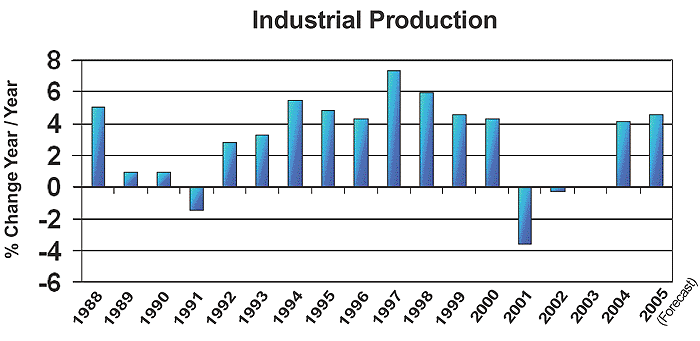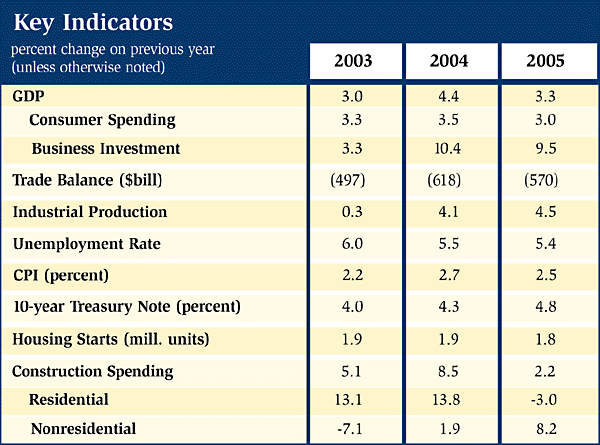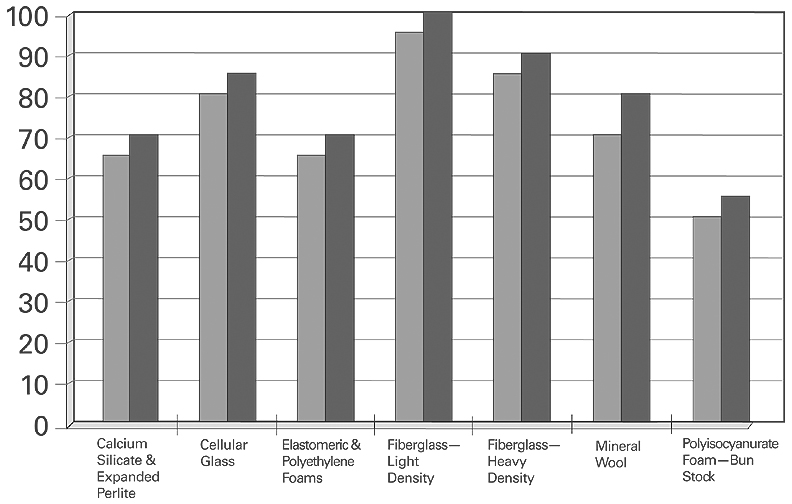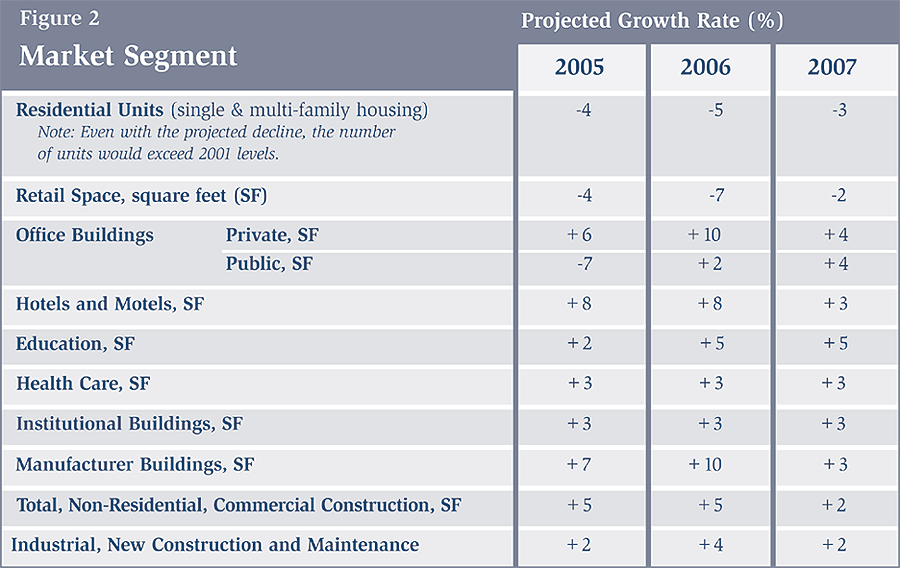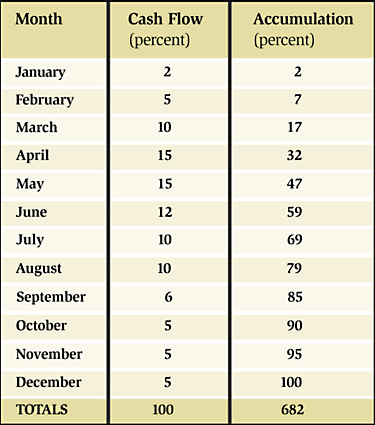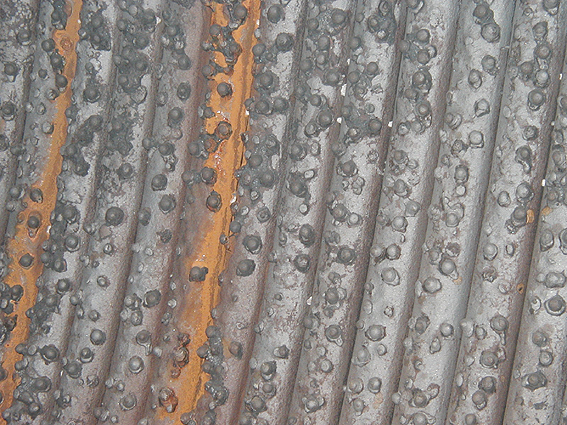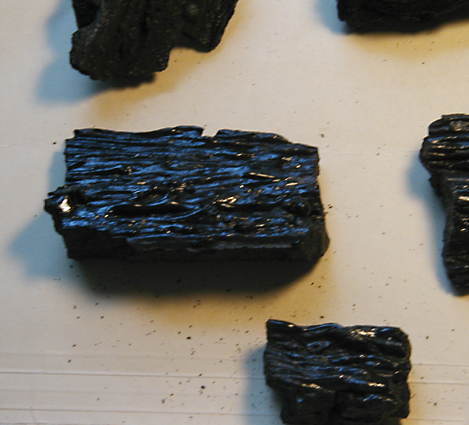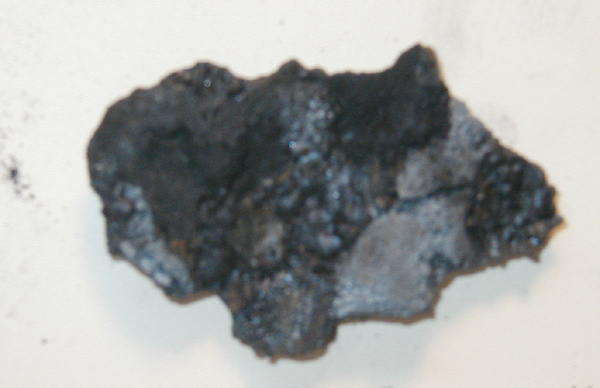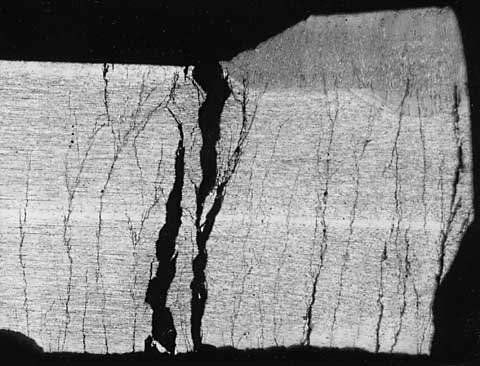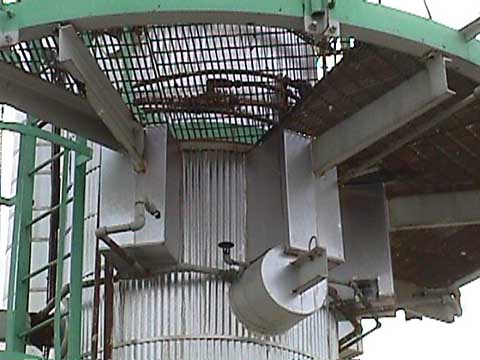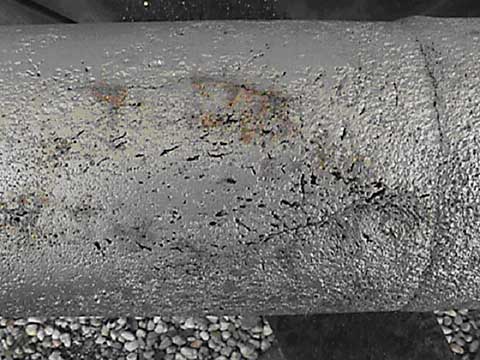Economic turbulence has left many U.S. business leaders skeptical of resurgence. However, despite recent setbacks, the outlook is bright for many of the industries that benefit from mechanical and industrial insulation–as well as the mechanical and industrial insulation industry itself.
Macroeconomic Situation and Outlook
Despite an unexpected steep increase in oil prices and a second-quarter slowdown, the U.S. economy continued its expansion during 2004. Following three consecutive years of job losses, the economy added 2.2 million jobs. While job growth was weaker than expected, those new jobs generated personal income that translated into strong consumer spending, which was up 3.5 percent for the year. A strong showing at the end of the year pushed retail sales up by 7.4 percent. Despite these gains, consumers were somewhat constrained by high oil prices, which spiked to a record high $55 per barrel in October, following supply disruptions from an unusually strong hurricane season on top of already tight supplies.
Consumers also faced higher inflation in fuel, food and medical care costs. But the U.S. economy proved resilient, and business conditions continued to improve. Industrial production rose by 4.1 percent, up from stagnant growth in 2003. As the industrial sector improved, so did companies’ balance sheets. The business sector rebounded with investment growing by 10.4 percent, the best year since 1998, when companies geared up for Y2K. And for the first time since the late 1990s, the business sector was the engine of growth. As a result, gross domestic product grew by 4.4 percent, the fastest since 1999.
Despite such a strong showing, several chinks in the armor have emerged, including growing trade and budget deficits and a lower savings rate. Driven by a dollar that is still strong relative to the Chinese yuan (which is pegged against the dollar), and strong domestic consumption, the trade deficit surged from $496 billion to $618 billion in 2004. Exports grew 11.6 percent on a lower dollar (relative to most free-floating currencies), but imports increased 15.8 percent. Also of concern, the budget deficit grew to $412.6 billion from $377.1 billion and the national savings rate dipped to 0.8 percent, the lowest level ever.
While challenges exist, the outlook for 2005 is solid. Expansion is set to continue for a fourth straight year, aided by lower oil prices, more job growth and sustained business investment. The Federal Reserve will continue its interest rate-tightening regimen. Oil prices are expected to be lower in 2005, averaging $42 to $45 per barrel, and inflation will be moderate. As the dollar drifts lower, exports will grow more rapidly than imports for the first time in nearly a decade, contributing to a smaller trade deficit. An additional 2 million jobs could be created this year, raising personal income. Combined with lower oil prices, this will allow consumer spending to rise 3 percent.
During the economic downturn, many companies postponed replacement and upgrade investments. Business investment rose sharply last year as profits returned. As the economy keeps growing, companies will likely maintain higher levels of investment. Business investment will rise 9.5 percent this year, compared to a 10.4 percent gain in 2004. Business investment in equipment and software was up 13.8 percent in 2004, with a surge in the fourth quarter from companies taking advantage of the last year for bonus depreciation. Companies will also continue inventory rebuilding, which will add to growth.
All told, 2005 will likely see the return of the so-called Goldilocks economy–not too hot, not too cold. Look for gross domestic product growth of 3.3 percent this year. According to a recent survey of economic forecasters by the Wall Street Journal, there is only a 11 percent chance of recession during 2005. However, there are several important risks to economic growth: a sharply lower dollar; higher oil prices; low savings rate; and looming trade and budget deficits. Furthermore, no contemporary economic outlook would be complete without the caveat that another terrorist attack could change everything.
Construction Outlook
During 2004, total construction spending rose at a rate of 8.5 percent as nonresidential building returned and homebuilders eked out one more solid year. The Dodge Index, a measure of construction activity, was up 9.5 percent in 2004. Last year, homebuilders posted 1.93 million housing starts, including 1.59 million single-family homes. Nonresidential contractors had their best year since 1998, with construction spending for private nonresidential building up by 1.9 percent, including gains in the commercial and manufacturing sectors.
Following four years of rapid growth driven by the housing market, construction is set to slow down in 2005. The residential sector that has boomed thanks to historically low mortgage rates will cool down as interest rates move back up. New housing starts are expected to fall by 5 percent this year to 1.83 million units. As a result, residential construction spending is set to fall by 3 percent.
However, commercial, industrial and public construction will pick up the pace this year. Retail construction has been growing and is driven by new home construction in addition to expansion by large retailers. Because there is a lag between new housing developments and the emergence of nearby shopping centers, growth in retail is expected to continue through 2005. Office construction is also growing, following several years of near dormancy following the glut of office space vacated by the dot-com bust. Office vacancy rates have fallen from 18.2 percent at the end of 2003 to 17.4 percent at the end of last year. McGraw Hill estimates that 170 million square feet of new office space will be built in 2005, up 9.7 percent from 2004.
Construction at utilities will fall, as much of the 200 gigawatts of new natural gas-fired capacity installed at the beginning of the decade is sitting idle, dampening demand for new generating capacity. Manufacturing construction will be a bright spot, however. The manufacturing recession that began in mid-2000 was the longest and deepest downturn in the post-World War II period. As discussed below, the manufacturing recovery has gained momentum that will continue through 2005. As business conditions and profitability continue to improve, capital expenditures on plant and equipment will rise as companies expand and accelerate capital maintenance projects and new construction that were delayed in years past. Nonresidential building construction will rise by 8.2 percent this year. Overall, construction spending is set to rise by 2.2 percent in 2005.
Industrial Outlook
Coming on the heels of one of the worst downturns in recent history, the industrial sector rebounded in 2004. Industrial production rose 4.1 percent in 2004 following three years of decline. Durable manufacturing, and in particular, high-tech manufacturing posted the largest gains. Capacity utilization rose from 75.5 percent to 78.1 percent, the largest one-year gain in more than a decade.
The Purchasing Managers Index, a measure of manufacturing activity, averaged 60.5 last year (a reading above 50 indicates expansion in manufacturing activity) and reached record highs during the first quarter. Business inventories rose 4.8 percent, but sales advanced at a faster rate, pushing the inventory-to-sales ratio to historically low levels. Much of the manufacturing recession can be blamed on a large inventory correction. As a result, businesses have been reluctant to rebuild large inventories. Additionally, improved supply-chain management practices and the substantial investment in computers and software have allowed companies to hold leaner inventories than in past years. At the end of 2004, inventory growth was picking up, reflecting optimism among market participants.
This year will be one of continued growth in the manufacturing sector. Industrial production will continue to improve, posting gains of 4.5 percent, and capacity utilization will tighten to 80.4 percent as businesses rebuild limited inventories.
Insulation End-Use Markets Outlook
Among the industries that posted gains in 2004, many were major consumers of industrial insulation, including chemicals, food processing, gas processing, shipbuilding, petroleum refining and paper. The outlook for 2005 is for continued gains as the manufacturing recovery moves forward. Not surprisingly, many insulation end-use industries are energy-intensive. Historically high oil and natural gas prices in 2004 motivated energy efficiency investments. This trend is likely to continue as prices are set to remain relatively high for several years to come.
Chemicals
Despite continued high energy prices, the chemical industry had a strong year with shipments up by 9 percent to $501 billion as demand strengthened in many consuming industries. A recovery was seen in nearly every segment of the chemical industry as volumes were up significantly from 2003. Total chemical industry volumes were up by 5.5 percent in 2004 and are expected to grow by 3.4 percent in 2005 and 2.9 percent in 2006, according to the American Chemistry Council (ACC). Petrochemical volumes were up by 5.9 percent in 2004, with gains of 2.5 percent expected in 2005 and 1.3 percent in 2006. Overall basic chemical volumes were up 4.5 percent for the past year and are expected to rise by 2.1 percent this year and 0.9 percent in 2006. ACC projects capital spending by chemical companies to grow 10.3 percent in 2005 to $25.7 billion, with a 13.0 percent gain in capital spending for the chemical industry, excluding pharmaceuticals. In 2006, spending growth will slow to 5.4 percent.
Food Processing
As food processors shifted their product lines toward low-carb and convenience items, shipments rose 5.6 percent following a 2.3 percent gain in 2003. Food processors found themselves squeezed between increasing retail price competition and higher prices for dairy, meat and other agricultural commodities. The outlook for food processing remains solid, with additional growth in prepared foods and nutraceutical foods and beverages. Additionally, exports of food, feed and beverages will rise as the dollar continues its move downward. In 2004, $55.9 billion worth of food products was exported.
Gas Processing
Since the mid-1990s, U.S. consumption of natural gas has grown more than any other fuel. In addition to its use in the residential and commercial sectors, natural gas is increasingly being used by the electric generating sector because of its relatively clean-burning properties. The U.S. Energy Information Administration (EIA) forecasts that natural gas demand will rise by 3.7 percent in 2005. Natural gas liquids (NGLs), i.e. ethane, propane and butane, are stripped out for sale to fuel distributors and petrochemical producers. As petrochemical demand has picked up, so has demand for ethane, the primary building block for ethylene, and other NGLs. The industrial production index for natural gas liquids extraction grew by 5.8 percent in 2004, following an 8.9 percent decline in 2003 as record high natural gas prices, held back the petrochemical recovery. Gas processors will also see a boost in coming years as more liquefied natural gas (LNG) capacity is brought online to meet soaring U.S. demand for natural gas.
Shipbuilding
Reflecting trends in greater global trade, defense and rising consumer spending, shipments of ships and boats grew 9.8 percent in 2004, following a 17.8 percent growth in 2003. The industrial production index for shipbuilding rose 8.8 percent in 2004. At the end of 2004, new orders for ships and boats were up, suggesting continued strength in 2005. Even as defense spending is set to decline, rapid growth in international trade will fuel demand for shipbuilding for the foreseeable future. Of particular interest are new orders for refrigerated tanker ships to transport LNG as world capacity expands. However, these tankers are not currently produced domestically.
Petroleum Refining
Oil prices surged as demand growth far exceeded supply growth, especially in the face of multiple disruptions from geopolitical and natural forces. Crack spreads (a measure of profitability for refiners) in 2004 were the highest in a decade. However, there will likely be downward pressure on margins as supply growth outpaces lower demand growth during the second half of 2005. In 2004, U.S. refinery capacity utilization fell to 92.2 percent, reflecting additions to capacity and hurricane-related shutdowns. EIA forecasts refinery capacity utilization to tighten to 94 percent in 2005 before easing slightly to 93.4 percent in 2006. EIA also projects capacity additions for an additional 200,000 barrels per day in 2005, pushing U.S. refining capacity to 17.1 million barrels per day.
Pulp and Paper
As with several other nondurable sectors, the pulp and paper industry has lagged the recovery. Following a 9 percent drop during longest and deepest downturn in the paper industry, the industry rebounded in 2004, driven by higher demand for packaging paperboard from manufacturers and paper by offices and publishers. The industrial production index for paper rose 1.6 percent in 2004 following a 0.5 percent decline in 2003. Reflecting the manufacturing recovery, the strongest growth occurred in paperboard, which grew 3.5 percent last year. Higher volumes combined with firmer pricing raised shipments of paper products by 7.4 percent in 2004, following 5.4 percent growth in 2003. According to the American Forest and Paper Association, output of paper and paperboard is set to grow by 2.5 percent during 2005. Pulp production typically follows paper and paperboard; so similar gains are expected in that sector as well.
Power
Power generation is dependent on economic growth and the weather. Despite a relatively mild summer, electricity generation grew by 2.1 percent in 2004 on stronger economic growth. EIA forecasts electric generation to increase by 3.4 percent to 4,062 billion kilowatt hours in 2005. New projections by EIA show that 26.6 gigawatts of capacity additions are planned at U.S. electric utilities in 2005, including 23.9 gigawatts of natural gas-fired generation. This is down 28 percent from last year’s estimates, reflecting concern over natural gas supplies and prices.
Conclusion
The fundamentals are in place for this year to see a return to the economic growth trend. Look to the strengthening business sector to drive growth in 2005 as corporate profitability strengthens and business conditions improve. Consumers will provide steady gains. Construction spending will rise slowly as gains in nonresidential building are offset by a cooling housing sector. The outlook for the insulation industry is strong for 2005. Growth in manufacturing construction, and increased capital spending, especially with an eye toward energy efficiency, will drive insulation sales in the coming year.


